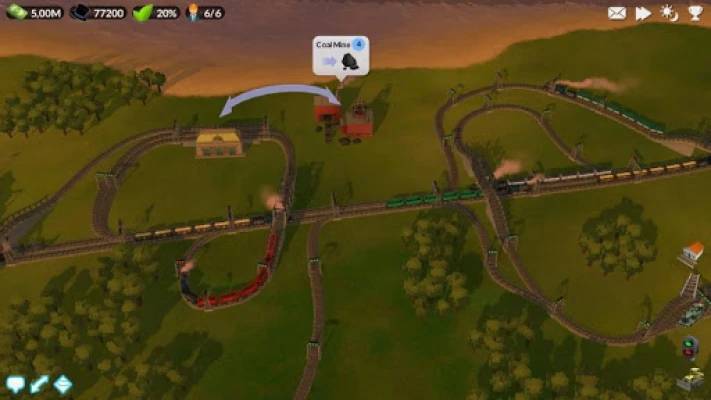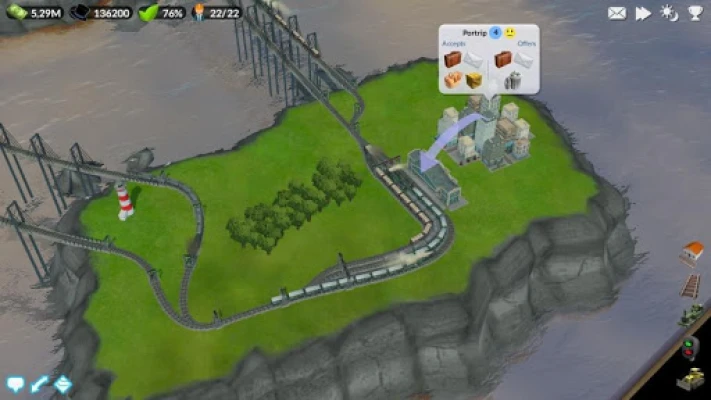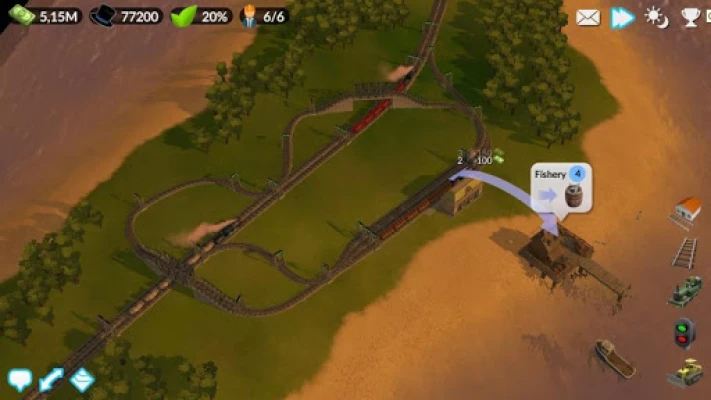
Latest Version
5.0.3
February 07, 2025
DeckEleven Entertainment
Games
Android
0
Free
com.deckeleven.railroads2
Report a Problem
More About DeckEleven's Railroads 2
Mastering Railway Management: Build Your Ultimate Network
Step into the shoes of a true tycoon and take command of your very own railway empire! In this comprehensive guide, we will explore how to design and construct the perfect railway network, offering you the tools and strategies needed to thrive in this dynamic industry.
Designing Your Railway Network
Creating an efficient railway network requires careful planning and strategic design. Start by mapping out your routes, considering the geography and population density of the areas you wish to serve. A well-planned network not only enhances connectivity but also maximizes profitability.
Choosing the Right Locomotives
One of the most critical decisions you will make is selecting the type of locomotives for your railway. You have three primary options:
- Steam Locomotives: These classic engines offer a nostalgic charm and are ideal for scenic routes, attracting tourists and history enthusiasts.
- Diesel Locomotives: Known for their efficiency and versatility, diesel engines are perfect for both freight and passenger services, providing a balance between power and cost.
- Electric Locomotives: The future of rail transport lies in electric engines, which are environmentally friendly and capable of high speeds, making them suitable for urban and intercity travel.
Managing Your Stations Effectively
Your railway stations serve as the backbone of your network. Efficient station management is crucial for ensuring smooth operations and customer satisfaction. Here are some key aspects to consider:
Station Design and Layout
Design your stations with passenger flow in mind. Ensure that ticketing, waiting areas, and boarding platforms are easily accessible. Incorporate amenities such as shops and restaurants to enhance the passenger experience and generate additional revenue.
Staffing and Operations
Hire skilled personnel to manage daily operations. From ticket agents to maintenance crews, having a dedicated team ensures that your stations run smoothly and efficiently. Regular training and development programs will keep your staff updated on best practices and safety protocols.
Optimizing Train Routes
Efficient train routing is essential for maximizing your network's potential. Analyze demand patterns and adjust your schedules accordingly. Consider the following strategies:
Data-Driven Decision Making
Utilize data analytics to understand passenger trends and cargo demands. This information will help you optimize your routes, ensuring that trains run at full capacity and meet customer needs.
Flexible Scheduling
Implement flexible scheduling to accommodate peak travel times and special events. By adjusting your timetable, you can enhance service reliability and customer satisfaction.
Research and Development: Staying Ahead of the Curve
Investing in research and development is vital for maintaining a competitive edge in the railway industry. Explore innovative technologies and practices that can improve efficiency and sustainability.
Embracing New Technologies
Stay informed about advancements in railway technology, such as automated systems, smart signaling, and energy-efficient trains. Implementing these innovations can significantly enhance your operations and reduce costs.
Environmental Sustainability
As the world shifts towards greener practices, consider how your railway can contribute to sustainability. Explore options for renewable energy sources and eco-friendly materials in your operations.
Financial Management: Balancing the Books
Effective financial management is crucial for the success of your railway network. Keep a close eye on your budget and explore various revenue streams.
Cost Control Strategies
Identify areas where you can reduce costs without compromising service quality. Regularly review your expenses and seek out more efficient suppliers and contractors.
Diverse Revenue Streams
Consider diversifying your revenue sources by offering additional services such as freight transport, advertising space at stations, and partnerships with local businesses. This approach can help stabilize your income and reduce reliance on passenger fares alone.
Fuel Logistics and Power Management
Efficient fuel logistics and power management are essential for keeping your trains running smoothly. Develop a comprehensive strategy to manage these resources effectively.
Fuel Supply Chain Management
Establish strong relationships with fuel suppliers to ensure a reliable and cost-effective supply chain. Monitor fuel consumption closely to identify areas for improvement and reduce waste.
Power Grid Optimization
For electric locomotives, optimizing your power grid is crucial. Invest in smart grid technology to manage energy consumption and reduce operational costs.
Conclusion: Your Journey to Railway Mastery
Building and managing a successful railway network is a complex yet rewarding endeavor. By focusing on strategic design, effective management, and continuous innovation, you can create a thriving railway empire that stands the test of time. Embrace the challenges and opportunities that come your way, and watch your railway network flourish!
Rate the App
User Reviews
Popular Apps










Editor's Choice































